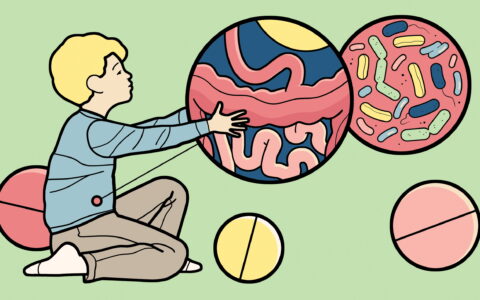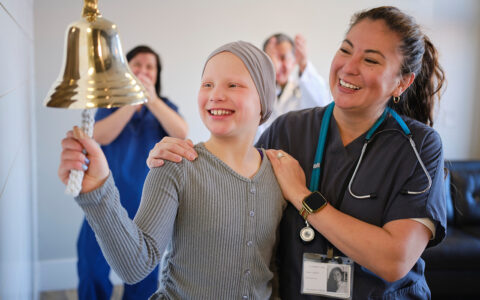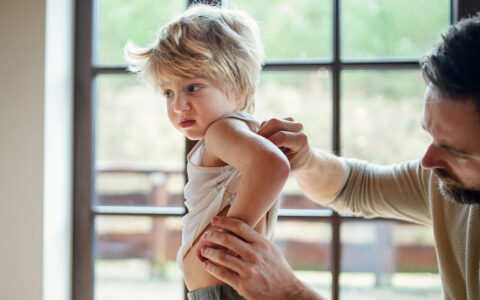Chronic abdominal pain is common in youth, with roughly 14 percent of children and teens experiencing the condition.
Although this type of chronic pain typically remits by adulthood, a 20-year longitudinal study led by clinical psychologist Amanda Stone, Ph.D., of Monroe Carell Jr. Children’s Hospital at Vanderbilt, shows that nearly half such patients have symptoms long after adolescence.
Published in The Journal of Pain, Stone’s research found that chronic abdominal pain in childhood “can have long-term effects on physical and mental health into adulthood.” And her results indicate these issues also may impact a subsequent generation.
Stone notes that incidence of chronic pain increases as children enter adolescence. Other common complaints at this age besides abdominal discomfort include headaches and backaches, she said. In cases where disease-based causes are ruled out for abdominal pain, it’s typically considered a “functional gastrointestinal disorder,” more recently called a “disorder of the gut-brain interaction,” Stone said.
Some older adolescents may experience relief from chronic pain while undergoing life changes – such as entering college and moving away from home. If those changes feel positive, they reduce stress and help reduce pain, Stone said.
However, for some youth, chronic abdominal pain follows them into adulthood.
Persistent Pain
With her colleagues, Stone followed a group of children from about age 11 who were either treated for pain at a pediatric gastroenterology clinic or recruited from public schools as a control group. The researchers then re-assessed them in early adulthood, at about age 20. The team did another assessment 10 years after that. The study asked them to report details of their pain, their physical and mental health and, at the final assessment, the pain status of their children, if applicable.
The researchers found that for about 37 percent of pediatric patients, chronic abdominal pain persists into at least early adulthood, or about age 20. About 20 percent of former pediatric patients reported chronic abdominal pain remaining by age 30, compared with 7.3 percent of the control group.
Participants who reported ongoing abdominal pain at each time point also reported lower health-related quality of life than those in the control group, including more instances of pain interfering with their lives, as well as anxiety, depression, fatigue, and disturbed sleep. The pain group also reported more health-related anxiety, specifically pain catastrophizing and body vigilance.
Loaded Legacy
The assessment of participants at about age 30 included specific questions for those who had children, asking about their offspring’s physical and mental health. The children of former pediatric chronic abdominal pain patients were reported to have more emotional problems than children in the original control group.
“They were more likely to report that their children experienced many fears and worry, felt unhappy, or complained of headaches,” Stone said.
This finding about issues facing the next generation “is consistent with previous theoretical frameworks suggesting that emotional distress is a potential pathway underlying the intergenerational risk for chronic pain,” the authors wrote.
Stone theorizes that some children have greater sensitivity in their central nervous systems than their peers, and thus experience more severe or more frequent pain. Catastrophizing about pain also seems to increase the chances that the pain will persist, she said.
Seeking More Evidence
Children of the original participants constitute a limited sample, and Stone noted that more longitudinal studies are needed to shed light on how chronic pain in childhood influences future parenting behaviors and how the next generation experiences pain.
Factors that may be considered include genetics, which can influence whether a child inherits a particularly sensitive nervous system that will react more strongly to pain. Social learning can also play a part.
A parent who has a fearful response to pain will likely react with more anxious attention to their child’s pain than parents with a more moderate pain-response history. Such demonstrations may condition the child to feel anxiety or fear about pain, which in turn could lead to them experience more frequently or intensely, Stone said.
“This really emphasizes that pain is a bio-psycho-social phenomenon,” an interplay of physical and behavioral influences, Stone said.
“Those who continue to have chronic pain also have higher scores on anxiety measures, more body vigilance, more pain catastrophizing. This is understandable when patients have been experiencing pain for a long time. And these are factors that really could be beneficial to address with some sort of concurrent mental health care or support as a part of the pain management plan.
Complex Sources
Chronic abdominal pain in children can start for many reasons – including infections – or for no apparent reason, Stone said. In some children, the pain hangs on long after the original cause is resolved.
“It’s like the nervous system has gotten stuck in this pain loop,” Stone said.
Stress is a common culprit.
“There is a huge relationship between stress and pain, and we consider it bidirectional,” she said. “Stressors influencing pain could be something social like school or friendships or physical like recovering from a viral illness.
“The physical inputs, the emotional inputs, other cognitive inputs – like where our attention is at the time – all of that goes into how much pain or suffering someone experiences.”
Pain Care at Vanderbilt
Stone practices at the Outpatient Pain Management Clinic at Monroe Carell. The clinic is dedicated to helping children and parents better manage chronic pain arising from a wide range of conditions, injuries, or surgeries.
In September 2022, Stone and colleagues began a clinic for the Multidisciplinary Assessment of Pain, which is staffed by a pain physician, pediatric psychologist, physical therapist and occupational therapist.
“The clinic uses a functional restoration approach helping youth get back to life activities they have often withdrawn from due to pain,” Stone said.






